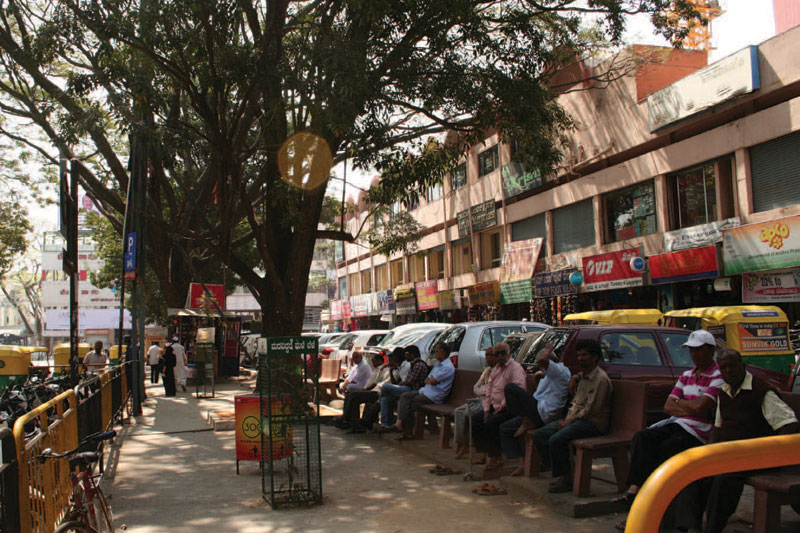Cities
Designing for the social lie of Indian Streets: A Case Study of Bangalore | Sneha Mandhan
LA 43 |
|
| An Indian street was once a cauldron of culture and sensory experiences that would act as the backdrop as well as focal point for societal interactions and communal activities. Today, however, these once socially vibrant streets have been reduced to a mere means to an end and do not carry the appeal or experiential quality of the then times. This case study uses examples from Bangalore to illustrate the importance and method of understanding the Indian streets and the social necessities that shape the street experience. |
|
 |
|
"A road is not an open book, neither is it a thought that can be pushed away or brought close through comment. Road is ink. It can be wet, it can be thick, it can be light, bright or faint. In it one can find new languages for ones own predicaments and flexibilities. When you return, you won't be the same as you were when you started. When we are in search, when we build, we create surprises for ourselves, and for others."
- from Cybermohalla Ensemble, "Eleven Streets"
Streets - the disappearing public spaces in India
Streets in India have traditionally been the public spaces around which urban social life has revolved. They constitute the urban public realm where people congregate, celebrate and interact. They serve as canvases for public expression against political regimes, for social issues and religious beliefs. They are the paths along which people move through the city and see, observe, experience and perceive.
However, with the process of rapid urbanization occurring throughout the country there is presently an increasing obsession with the concept of the 'global city' and the 'ideal city' among planners and real estate developers. Without understanding the specificities of urban planning in an Indian context, politicians are calling for models of Singapore, Tokyo, London and Paris to be developed in India. In this process streets are becoming engineered for vehicular efficiency along Western street standards and are consequently losing the characteristics that made them socially and culturally vibrant.
Today, cities all around the world are focused on developing pedestrian friendly cities which presents an opportunity for Indian cities to catch up with their Western counterparts and revive the vibrancy of traditional Indian streets. Few cities in India have spearheaded efforts in this direction. Cities like New Delhi, Ahmedabad and Bangalore have recently published new street design guidelines which address several issues including safety and traffic flows; however there are yet several social aspects of these spaces that need to be understood and addressed. This article uses Bangalore as a case study to present a set of criteria that can be used to assess, plan and design great Indian streets through an analysis of the spatial and social forces that shape street experience and culture.
|
|


|
|

|
|
|
|
| CURRENT ISSUE: LA-61 |
|
|
|
|
environment, ecology and biodiversity |
RESCUING THE URBAN POLLINATORS
MADHURA KHADE
WETLANDS AT WORK
UNDERSTANDING WETLANDS
With inputs from Dr. C. R. Babu
CONSTRUCTED WETLAND AT RAJOKRI, NEW DELHI
[Delhi Jal Board]
Ankit Srivastava
CONSTRUCTED WETLAND AT NEELA HAUZ, NEW DELHI
Landscape and Environment Planning Department,
Delhi Development Authority
CONSTRUCTED WETLAND AT HAUZ KHAS LAKE, NEW DELHI
Tarun Nanda, Evolve Engineering
RESTORATION AND REJUVENATION OF RIVER YAMUNA FLOODPLAINS, NEW DELHI
Landscape and Environment Planning Department,
Delhi Development Authority
REIMAGINING THE CITY
YAMUNA RIVER PROJECT:NEW DELHI URBAN ECOLOGY
[Authors Inaki Alday and Pankaj Vir Gupta]
Review by Geeta Wahi Dua
REJUVENATION AND RESTORATION OF URBAN PONDS, GURUGRAM
Future Institute
SPURRING ECONOMIC REVIVAL THROUGH ECOLOGICAL RESTORATION,
NANHU, CHINA
Uma Sekar
heritage, urban design, landscape architecture |
FROM MY HOUSE TO YOUR HOUSE
In conversation with Miki Desai
CITY MAPS: MAPPING NATURE AND ENVIRONMENT
Review by Rabindra J. Vasavada
A SENSE OF SPACE
Anuraag Chowfla
IN CONVERSATION WITH RANJIT SABIKHI
DEMOCRACY, PARTICIPATION AND CONSULTATION
In conversation with Bimal Patel
city and culture |
OUR CITIES CAN FIGHT COVID-19 PROACTIVELY
Mriganka Saxena and Puneet Khanna
LOCALIZING FUTURES
Geeta Wahi Dua
BOURGEOIS ENVIRONMENTALISM AND THE VULNERABILITY OF THE POOR
UNCIVIL CITY: ECOLOGY, EQUITY AND THE COMMONS IN DELHI [Author: Amita Baviskar]
Review by Nikhil Dhar
STREETSCAPES IN PUNE
CREATING A HEALTHY AND WALKABLE NEIGHBORHOOD: AUNDH NEIGHBORHOOD UPGRADATION | PUNE
Prasanna Desai Architects
ABOUT RETAIL, TREES AND YOUNG VIBES:
JANGLI MAHARAJ ROAD | PUNE
Oasis Designs Inc.
EMERGENCE OF THE EPHEMERAL
Bijoy Ramachandran
seeing the unseen |
ART FOR ALL
St+Art India Foundation
|
|